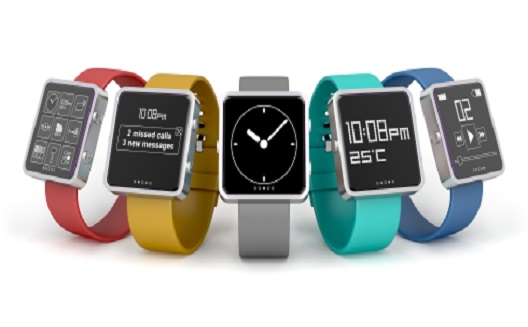6 of the hottest smartwatches: fashion trend or smartphone alternative?


In 1973, Motorola introduced the first wireless "hand-held cell phone." Twenty years later, in 1993, IBM and American telecommunication company BellSouth introduced the first "smartphone." Now, in 2013, after another 20 years, we're seeing a new revolution: Wearables.
From Google Glass, and wristwatch Pebble to swimming hardware Instabeat, smartwatches, smartbracelets and smarteyewear are creating a new market. Whether they will become as mainstream as smartphones (or replace them one day, as smartphones are beginning to with regular mobiles) remains to be seen.
A recent study on Business Insider shows that wearable devices are set to skyrocket, growing from 14 million devices in 2011 to an expected 171 million by 2016, as medical and fitness wearables in particular become wildly popular.
One trend in this niche is smartwatches, which mostly build from the functionality of smartphones. Lately, it seems like everyone's launching one. Here's a look at some of the most popular ones:
 Pebble: In addition to telling the time, this smartwatch synchronizes with your smartphone’s music library, allowing you to play and pause tracks, gives you caller ID for incoming calls after synchronizing with your address book, and lets you text and send emails too. On Forbes, Matthew Stibbe called it "genuinely useful."
Pebble: In addition to telling the time, this smartwatch synchronizes with your smartphone’s music library, allowing you to play and pause tracks, gives you caller ID for incoming calls after synchronizing with your address book, and lets you text and send emails too. On Forbes, Matthew Stibbe called it "genuinely useful."
 Galaxy Gear: Samsung’s newest addition is the Galaxy Gear smartwatch, which works with the Samsung Galaxy S3, S4, Galaxy Note 2, Galaxy S4 Mini, Galaxy S4 Zoom and Galaxy Mega 5.8 and 6.3 and others. Despite the fact that Matt McFarlane at the Washington Post called it a flop for being so bulky and clunky, Samsung has shipped 800.000 Gears in two months, The Verge reported.
Galaxy Gear: Samsung’s newest addition is the Galaxy Gear smartwatch, which works with the Samsung Galaxy S3, S4, Galaxy Note 2, Galaxy S4 Mini, Galaxy S4 Zoom and Galaxy Mega 5.8 and 6.3 and others. Despite the fact that Matt McFarlane at the Washington Post called it a flop for being so bulky and clunky, Samsung has shipped 800.000 Gears in two months, The Verge reported.
 Google’s smartwatch: As if Google Glass wasn’t enough to draw everyone's attention to Google's wearables, the company will start manufacturing its own line of smartwatches "within months," The Next Web reported.
Google’s smartwatch: As if Google Glass wasn’t enough to draw everyone's attention to Google's wearables, the company will start manufacturing its own line of smartwatches "within months," The Next Web reported.
- iWatch: Apple will be releasing a new smartwatch in the second half of 2014, which is rumored to have different screen sizes for men and women.
 Adidas’s miCoach SMART RUN: This smartwatch is tailored for runners, and fits into the quantified self variety of smart devices, as it shows location, speed and heart rate. What makes it special is that users don’t need to link it to a smartphone, so it can be used completely independently.
Adidas’s miCoach SMART RUN: This smartwatch is tailored for runners, and fits into the quantified self variety of smart devices, as it shows location, speed and heart rate. What makes it special is that users don’t need to link it to a smartphone, so it can be used completely independently.
 Nike Fuel Band: This device could be called a smartwatch, because technically, it displays the time. But it's also a self-tracker, measures all the activities a person does throughout the day, from walking back and forth to work every day to jogging at night or even making the simplest movements during the day.
Nike Fuel Band: This device could be called a smartwatch, because technically, it displays the time. But it's also a self-tracker, measures all the activities a person does throughout the day, from walking back and forth to work every day to jogging at night or even making the simplest movements during the day.
These are just a few of the most popular; for more on niche smartwatches, including a few failed ideas, check out this list of 16 smartwatches to look for.
It’s all about the fashion
Part of what will make these devices so amazing to use is the functionality; by adding the ability for Google Glass to stream music from Google Play or incorporate with Nissan cars, Google is continuing to advance our ability to create a new sense of reality.
But another basic factor, especially for smartwatches, is design, and even the fashion; no one wants to buy an ugly or clunky wearable, no matter how great its functions are. Apple for one, has demonstrated its investment in aesthetics by hiring Burberry’s CEO Angela Ahrendts to be Senior Vice President of Retail and Online Stores.
Fashion is also the center of attention for the creators of MEMI, a bracelet for women that replaces the smartphone's big screen and "geek-centric design" with a slim design that notifies you about important phone calls by vibrating silently on your wrist.
These wearables are cool and trendy, but if they're even intended to become more popular than smartphones, they may need to have a competitive edge; will users want to invest in devices that merely extend the functionality of their phones? Or will they demand that wearables involve more sophisticated features, like self-tracking? Which wearables would you buy?


